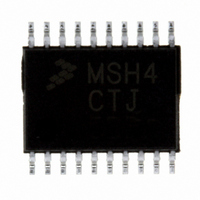MC9S08SH4CTJ Freescale Semiconductor, MC9S08SH4CTJ Datasheet - Page 175

MC9S08SH4CTJ
Manufacturer Part Number
MC9S08SH4CTJ
Description
IC MCU 8BIT 4K FLASH 20-TSSOP
Manufacturer
Freescale Semiconductor
Series
HCS08r
Datasheet
1.MC9S08SH4CTJ.pdf
(338 pages)
Specifications of MC9S08SH4CTJ
Core Processor
HCS08
Core Size
8-Bit
Speed
40MHz
Connectivity
I²C, LIN, SCI, SPI
Peripherals
LVD, POR, PWM, WDT
Number Of I /o
17
Program Memory Size
4KB (4K x 8)
Program Memory Type
FLASH
Ram Size
256 x 8
Voltage - Supply (vcc/vdd)
2.7 V ~ 5.5 V
Data Converters
A/D 12x10b
Oscillator Type
Internal
Operating Temperature
-40°C ~ 85°C
Package / Case
20-TSSOP
Processor Series
S08SH
Core
HCS08
Data Bus Width
8 bit
Data Ram Size
256 B
Interface Type
SCI/SPI
Maximum Clock Frequency
40 MHz
Number Of Programmable I/os
17
Number Of Timers
3
Operating Supply Voltage
2.7 V to 5.5 V
Maximum Operating Temperature
+ 85 C
Mounting Style
SMD/SMT
3rd Party Development Tools
EWS08
Development Tools By Supplier
DEMO9S08SG32, DEMO9S08SG32AUTO, DEMO9S08SG8, DEMO9S08SG8AUTO, DEMO9S08SH32, DEMO9S08SH8
Minimum Operating Temperature
- 40 C
On-chip Adc
12-ch x 10-bit
A/d Bit Size
10 bit
A/d Channels Available
12
Height
1.05 mm
Length
6.6 mm
Supply Voltage (max)
5.5 V
Supply Voltage (min)
2.7 V
Width
4.5 mm
Lead Free Status / RoHS Status
Lead free / RoHS Compliant
Eeprom Size
-
Lead Free Status / Rohs Status
Lead free / RoHS Compliant
Available stocks
Company
Part Number
Manufacturer
Quantity
Price
Part Number:
MC9S08SH4CTJR
Manufacturer:
FREESCALE
Quantity:
20 000
- Current page: 175 of 338
- Download datasheet (4Mb)
11.4.1.3
Before successful slave addressing is achieved, the data transfer can proceed byte-by-byte in a direction
specified by the R/W bit sent by the calling master.
All transfers that come after an address cycle are referred to as data transfers, even if they carry sub-address
information for the slave device
Each data byte is 8 bits long. Data may be changed only while SCL is low and must be held stable while
SCL is high as shown in
transferred first. Each data byte is followed by a 9th (acknowledge) bit, which is signalled from the
receiving device. An acknowledge is signalled by pulling the SDA low at the ninth clock. In summary, one
complete data transfer needs nine clock pulses.
If the slave receiver does not acknowledge the master in the ninth bit time, the SDA line must be left high
by the slave. The master interprets the failed acknowledge as an unsuccessful data transfer.
If the master receiver does not acknowledge the slave transmitter after a data byte transmission, the slave
interprets this as an end of data transfer and releases the SDA line.
In either case, the data transfer is aborted and the master does one of two things:
11.4.1.4
The master can terminate the communication by generating a stop signal to free the bus. However, the
master may generate a start signal followed by a calling command without generating a stop signal first.
This is called repeated start. A stop signal is defined as a low-to-high transition of SDA while SCL at
logical 1 (see
The master can generate a stop even if the slave has generated an acknowledge at which point the slave
must release the bus.
11.4.1.5
As shown in
signal to terminate the communication. This is used by the master to communicate with another slave or
with the same slave in different mode (transmit/receive mode) without releasing the bus.
11.4.1.6
The IIC bus is a true multi-master bus that allows more than one master to be connected on it. If two or
more masters try to control the bus at the same time, a clock synchronization procedure determines the bus
clock, for which the low period is equal to the longest clock low period and the high is equal to the shortest
one among the masters. The relative priority of the contending masters is determined by a data arbitration
procedure, a bus master loses arbitration if it transmits logic 1 while another master transmits logic 0. The
losing masters immediately switch over to slave receive mode and stop driving SDA output. In this case,
Freescale Semiconductor
•
•
Relinquishes the bus by generating a stop signal.
Commences a new calling by generating a repeated start signal.
Figure
Data Transfer
Stop Signal
Repeated Start Signal
Arbitration Procedure
Figure
11-9, a repeated start signal is a start signal generated without first generating a stop
11-9).
Figure
11-9. There is one clock pulse on SCL for each data bit, the msb being
MC9S08SH8 MCU Series Data Sheet, Rev. 3
Chapter 11 Inter-Integrated Circuit (S08IICV2)
175
Related parts for MC9S08SH4CTJ
Image
Part Number
Description
Manufacturer
Datasheet
Request
R
Part Number:
Description:
Manufacturer:
Freescale Semiconductor, Inc
Datasheet:
Part Number:
Description:
Manufacturer:
Freescale Semiconductor, Inc
Datasheet:
Part Number:
Description:
Manufacturer:
Freescale Semiconductor, Inc
Datasheet:
Part Number:
Description:
Manufacturer:
Freescale Semiconductor, Inc
Datasheet:
Part Number:
Description:
Manufacturer:
Freescale Semiconductor, Inc
Datasheet:
Part Number:
Description:
Manufacturer:
Freescale Semiconductor, Inc
Datasheet:
Part Number:
Description:
Manufacturer:
Freescale Semiconductor, Inc
Datasheet:
Part Number:
Description:
Manufacturer:
Freescale Semiconductor, Inc
Datasheet:
Part Number:
Description:
Manufacturer:
Freescale Semiconductor, Inc
Datasheet:
Part Number:
Description:
Manufacturer:
Freescale Semiconductor, Inc
Datasheet:
Part Number:
Description:
Manufacturer:
Freescale Semiconductor, Inc
Datasheet:
Part Number:
Description:
Manufacturer:
Freescale Semiconductor, Inc
Datasheet:
Part Number:
Description:
Manufacturer:
Freescale Semiconductor, Inc
Datasheet:
Part Number:
Description:
Manufacturer:
Freescale Semiconductor, Inc
Datasheet:
Part Number:
Description:
Manufacturer:
Freescale Semiconductor, Inc
Datasheet:











